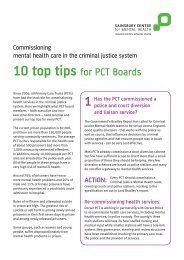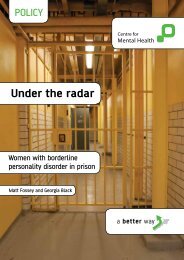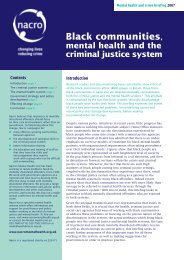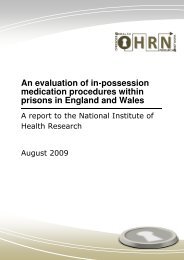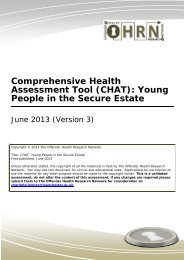Engendering Justice - from Policy to Practice - The Fawcett Society
Engendering Justice - from Policy to Practice - The Fawcett Society
Engendering Justice - from Policy to Practice - The Fawcett Society
- No tags were found...
Create successful ePaper yourself
Turn your PDF publications into a flip-book with our unique Google optimized e-Paper software.
Moving TowardsCommunity Provision<strong>The</strong> potential for change and the delivery of effectiveservices for women is considerable…However, thereality may be very different, especially since women area minority group within the criminal justice system. <strong>The</strong>capacity of agencies <strong>to</strong> attend <strong>to</strong> gender-specific needsis under question; the quality of inter-agency cooperationis variable; and the position of the voluntary sec<strong>to</strong>r in asupportive role may be stronger in some geographicalareas than others. 90<strong>The</strong> Government’s commitment <strong>to</strong> building the capacityof one s<strong>to</strong>p shop services at women’s centres andother specialist provision for women in the communitythrough investment in third sec<strong>to</strong>r providers is crucial. <strong>The</strong>Commission is encouraged by the announcement of £15.6million of new funding <strong>to</strong>wards the provision of additionalservices in the community for women offenders includingspecialist community provision and the development ofbail support services. However, this amount falls well shor<strong>to</strong>f the amount needed <strong>to</strong> develop a national network ofcommunity provision. <strong>The</strong> Rethinking Crime & Punishmentreport estimates a budget of £4.5 million per region – anational <strong>to</strong>tal of £45million/year (£261 million/6 years) <strong>to</strong>introduce a coordinated multi agency approach acrossthe country <strong>to</strong> reduce imprisonment for women – withcommunity based centres in major cities and flexible access<strong>to</strong> services in rural areas. 91Investment in community provision in the short term hasthe potential <strong>to</strong> save the public purse in the long term (forexample, the average cost of a place at the Asha Centre isno greater than £750 compared <strong>to</strong> £77,000 for the cost ofa prison place) as well as reducing reoffending rates and theharm caused <strong>to</strong> offenders’ families. A recent report by theNew Economics Foundation found that the social cost <strong>to</strong>children and <strong>to</strong> the state of imprisoning mothers for nonviolen<strong>to</strong>ffences <strong>to</strong>talled £17 million over ten years. 92A study commissioned by the <strong>Fawcett</strong> <strong>Society</strong> in 2007in<strong>to</strong> provision for women offenders in the communityrevealed a number of identified needs and best practicerecommendations. 93 Nine lessons were pin-pointed askey <strong>to</strong> the success of community provision for womenoffenders. In summary, such provision should:• be women-only <strong>to</strong> foster safety and a sense ofcommunity;• integrate offenders with non-offenders <strong>to</strong> normalisewomen’s experiences;• foster women’s empowerment <strong>to</strong> build self esteem andmotivate women <strong>to</strong> seek employment;• draw on knowledge of effective learning styles for women;• take a holistic and practical approach which focuseson addressing social problems which may be linked<strong>to</strong> offending; including through links with mainstreamagencies (such as health, counselling and debt advice);• have the capacity and flexibility <strong>to</strong> allow women <strong>to</strong> returnfor continued support and development as required;• offer women personal support through the provision of amen<strong>to</strong>r; and• provide women with practical help with childcare andtransport <strong>to</strong> enable them <strong>to</strong> attend on a consistent basis.<strong>The</strong> Together Women Programme has proven the successof such provision, offering a flexible means of support whichcan be delivered according <strong>to</strong> individual need and localresources. <strong>The</strong> two demonstration projects have showngreat potential for reducing reoffending rates and providingwomen with a pathway back in<strong>to</strong> the community. According<strong>to</strong> a report produced by the Esmee Fairbairn Foundation inJuly 2008, early results <strong>from</strong> the TWP had demonstratedconsiderable success with an 8 percent reoffending ratecompared with a 55 percent national reoffending ratefor women. 94 Bris<strong>to</strong>l Eden House Project is the latestdemonstration pilot. Due <strong>to</strong> launch in summer 2009, theproject will offer residential, day and out-reach services <strong>to</strong>local women offenders as well as working with statu<strong>to</strong>ryand voluntary sec<strong>to</strong>r agencies <strong>to</strong> establish a coordinatedresponse. However, these community projects remain fewand far between and there is a need for a co-ordinated rollou<strong>to</strong>f projects <strong>to</strong> each county area.Page 41







